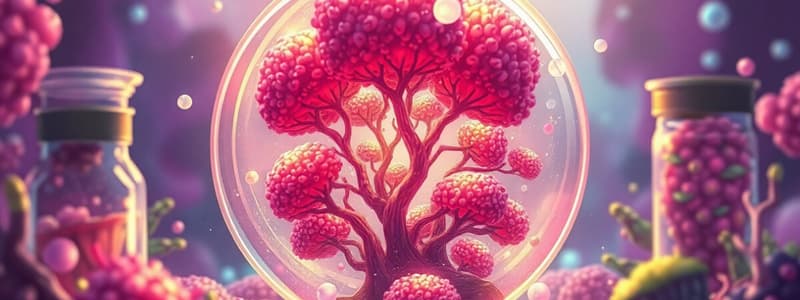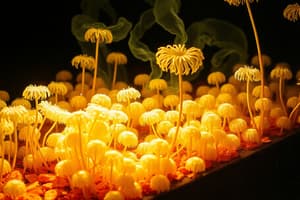Podcast
Questions and Answers
What is one essential requirement for growing microorganisms?
What is one essential requirement for growing microorganisms?
- High salinity levels
- Constant ultraviolet light exposure
- Availability of metabolically accessible nutrients (correct)
- Limited temperature range
Which of the following is NOT a method for isolating microorganisms in pure culture?
Which of the following is NOT a method for isolating microorganisms in pure culture?
- Streak plating
- Filtration method (correct)
- Plating method
- Dilution method
What type of organisms are able to generate metabolic energy through photosynthesis?
What type of organisms are able to generate metabolic energy through photosynthesis?
- Certain bacteria and plants (correct)
- Only fungi
- Only anaerobes
- Only prokaryotes
In the cultivation of microorganisms, which factor is crucial for maintaining chemical gradients across cell membranes?
In the cultivation of microorganisms, which factor is crucial for maintaining chemical gradients across cell membranes?
What role does agar play in microbial media?
What role does agar play in microbial media?
Why is it important to determine the number and type of organisms in a given material?
Why is it important to determine the number and type of organisms in a given material?
What is the main goal of the dilution method when isolating microorganisms?
What is the main goal of the dilution method when isolating microorganisms?
What is a significant factor that must be controlled during the growth of microorganisms?
What is a significant factor that must be controlled during the growth of microorganisms?
What characterizes the lag phase in bacterial growth?
What characterizes the lag phase in bacterial growth?
Which phase of the bacterial growth curve is characterized by cells dividing at a constant rate?
Which phase of the bacterial growth curve is characterized by cells dividing at a constant rate?
What occurs during the maximum stationary phase?
What occurs during the maximum stationary phase?
What is a key process that occurs during the exponential phase?
What is a key process that occurs during the exponential phase?
Which statement correctly describes the decline or death phase?
Which statement correctly describes the decline or death phase?
How can cells be maintained in the exponential phase of growth?
How can cells be maintained in the exponential phase of growth?
What significant metabolic activity occurs during the lag phase?
What significant metabolic activity occurs during the lag phase?
During which growth phase does the population grow most rapidly?
During which growth phase does the population grow most rapidly?
Flashcards
Cultivation
Cultivation
The process of growing and reproducing organisms by providing them with suitable living conditions.
Metabolic Energy
Metabolic Energy
The energy required for cells to create essential molecules and maintain their internal environment.
Fermentation
Fermentation
The process of breaking down sugars to release energy, without using oxygen.
Respiration
Respiration
Signup and view all the flashcards
Photosynthesis
Photosynthesis
Signup and view all the flashcards
Microbial Medium
Microbial Medium
Signup and view all the flashcards
Plating Method
Plating Method
Signup and view all the flashcards
Dilution Method
Dilution Method
Signup and view all the flashcards
Lag Phase
Lag Phase
Signup and view all the flashcards
Exponential Phase
Exponential Phase
Signup and view all the flashcards
Stationary Phase
Stationary Phase
Signup and view all the flashcards
Decline/Death Phase
Decline/Death Phase
Signup and view all the flashcards
Bacterial Growth
Bacterial Growth
Signup and view all the flashcards
Generation Time
Generation Time
Signup and view all the flashcards
Batch Culture
Batch Culture
Signup and view all the flashcards
Maintaining Exponential Phase
Maintaining Exponential Phase
Signup and view all the flashcards
Study Notes
Cultivation of Microorganisms
- Cultivation is the process of growing organisms by providing suitable environmental conditions.
- Organisms need energy for macromolecule synthesis and maintaining chemical gradients.
- Essential nutrients must be available in a usable form.
- Factors like nutrients, pH, temperature, aeration, salt concentration, and ionic strength must be controlled during growth.
- Metabolic energy generation occurs through fermentation, respiration, and photosynthesis.
Cultivation Methods
- Two key considerations in culturing microorganisms are choosing a suitable medium and isolating bacteria in pure culture.
- Cultivating microorganisms involves raising a crop of cells from a particular species, determining the types and numbers of organisms present in a sample, and isolating a specific organism from a natural source.
- A single cell needs to be isolated and cultivated to ensure all subsequent cells originated from that single cell.
Isolation of Microorganisms in Pure Culture
- Plating Method: Placing a small number of cells on a solidified medium allows each cell to grow into a separate colony.
- Agar is a common solidifying agent extracted from red algae.
- Dilution Method: Reducing the density of microorganisms through serial dilution. The diluted sample is then plated or inoculated, allowing each single cell to grow into a pure colony.
- Samples of each diluted solution are plated or streaked on a solid medium.
Survival of Microorganisms in the Natural Environment
- The number of microorganisms in the biosphere remains relatively constant.
- Survival depends on maintaining a living pool of organisms and successfully competing for necessary nutrients.
The Meaning of Growth
- Growth refers to an increase in the overall components of an organism.
- In unicellular organisms like bacteria, growth involves cell duplication, increasing the population size.
The Growth Curve
- The bacterial growth curve illustrates the population dynamics of bacteria in a closed system.
- Distinct phases in the curve are:
- Lag phase: Initial adjustment to the new environment, minimal growth.
- Exponential/log phase: Rapid cell division, constant doubling rate.
- Stationary phase: Cell division rate equals the death rate, constant population size.
- Death phase: Number of dying cells exceeds the number of growing cells; population declines.
The Phases of Bacterial Growth
- 1. Lag Phase:* Bacteria adapt to their environment; metabolic activity increases, but little to no cell division occurs.
- 2. Exponential Phase:* Cells divide at a constant rate, creating exponential growth. This phase is highly sensitive to antibiotics and environmental changes. Key processes are DNA replication, protein synthesis, and maximum nutrient utilization.
- 3. Stationary Phase:* Growth rate slows as nutrients are depleted and waste accumulates; new cell production equals cell death, resulting in a stable population.
- 4. Death Phase:* Nutrients become exhausted, waste products accumulate, increasing the death rate of cells. Cells may form spores or enter a dormant state.
Studying That Suits You
Use AI to generate personalized quizzes and flashcards to suit your learning preferences.




